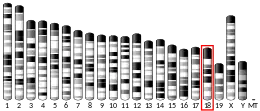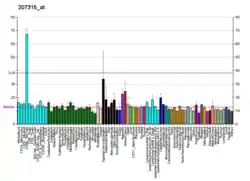CD226
CD226 (Cluster of Differentiation 226), PTA1 (outdated term, 'platelet and T cell activation antigen 1')[5] or DNAM-1 (DNAX Accessory Molecule-1)[5] is a ~65 kDa immunoglobulin-like transmembrane glycoprotein expressed on the surface of natural killer cells, NK T cell, B cells, dendritic cells, hematopoietic precursor cells, platelets, monocytes and T cells.[6]
DNAM-1 gene CD226 is conserved between human and mice. In humans the CD226 gene is located on chromosome 18q22.3.[7] In mice the CD226 gene is located on chromosome 18E4.
Structure
DNAM-1 is composed of three domains: an extracellular domain of 230 amino acids with two immunoglobin-like V-set domains and eight N-glycosylation sites, a transmembrane domain of 28 amino acids and a cytosolic domain of 60 amino acids containing four putative tyrosine residues and one serine residue for phosphorylation.[8]
Signaling
Upon engagement to its ligand, DNAM-1 is phosphorylated by protein kinase C. Then adhesive molecule LFA-1 crosslinks with DNAM-1 that results in recruitment of DNAM-1 to lipid rafts and promotes association with actin cytoskeleton. Cross-linking with LFA-1 also induce phosphorylation on Tyr128 and Tyr113 by Fyn Src kinase.[9]
DNAM-1 and CD244 together promotes phosphorylation of SH2 domain of SLP-76. This leads to activation of phospholipase Cγ2, Ca2+ influx, cytoskeletal reorganization, degranulation, and secretion.[8]
Function
DNAM-1 mediates cellular adhesion to other cells bearing its ligands, nectin molecule CD112 and nectin-like protein CD155,[10][11] that are broadly distributed on normal neuronal, epithelial, fibroblastic cells, dendritic cells, monocytes and on infected or transformed cells.
DNAM-1 promotes lymphocyte signaling, lymphokine secretion and cytotoxicity of NK cells and cytotoxic CD8+ T lymphocytes.[6] Cross-linking of DNAM-1 with antibodies causes cellular activation.[7]
DNAM-1 participates on platelets activation and aggregation.[8]
DNAM-1 possibly plays a role in trans-endothelial migration of NK cells because it was shown that monoclonal antibodies against DNAM-1 or CD155 inhibit this process.[9]
DNAM-1 interaction with its ligands promotes killing of immature and mature dendritic cells, is involved in the crosstalk between NK cells and T lymphocytes and can lyse activated T lymphocytes during graft versus host disease (GvHD).[8][9]
DNAM-1 also participates in the immunological synapse where is colocalized with LFA-1.[9]
DNAM-1 regulation
DNAM-1 expression on NK cells can be regulated by cell-cell interaction and by soluble factors. In human, IL-2 and IL-15 up-regulate DNAM-1 expression, whereas TGF-β, indolamine 2,3-dioxygenase and chronic exposure to CD155 can down-regulate DNAM-1 expression on NK cells.[9]
DNAM-1 and NK cells
DNAM is involved in NK cell education, differentiation, cytokine production and immune synapse formation. DNAM-1 exerts synergistic roles in NK cells regulation with three molecules that are TIGIT, CD96 and CRTAM.[9]
Cytotoxic response of NK cells might require synergistic activation from specific pairs of receptors. DNAM-1 could synergize with SLAM family member 2B4 (CD244) or with other receptors to induce full NK cell activation.[8]
DNAM-1 in cancer
The role of DNAM-1 in tumor environment was firstly described in vivo using RMA lymphoma model. In this model, enforced expression of DNAM-1 ligands CD155 and CD112 increased tumor rejection. CD155 and CD112 are expressed on the surface of a wide number of tumor cells in solid and lymphoid malignances such as lung carcinoma, primary human leukemia, myeloma, melanoma, neuroblastoma, ovarian cancer, colorectal carcinoma, and Ewing sarcoma cells.[9]
The role of DNAM-1 in the killing of tumor cells was supported with DNAM-/- mice model that was more susceptible to formation of spontaneous fibrosarcoma.[8]
It was shown that NK cells can kill leukemia and neuroblastoma cells expressing CD155 and block of CD155 or DNAM-1 results in inhibition of tumor cells lysis.[9]
In vivo, tumor cells are capable of evading DNAM-1 tumor suppressing mechanisms. Tumor cells can downregulate CD155 or CD112 to disable recognition of these DNAM-1 ligands. The other mechanism is a downregulation of DNAM-1 from the effector NK cell surface due to the chronic ligand (CD155) exposure.[9]
DNAM-1 was also used in T lymphocytes with a chimeric antigen receptors (CAR) for the treatment of cancer.[12]
DNAM-1 and infections
DNAM-1 has a relevant role in the process of recognizing virus-infected cells during early infection for example in case of cytomegalovirus infection by NK cells. DNAM-1 ligands are also expressed in antigen-presenting cells activated by toll-like receptors and CD155 might be activated by DNA-damage response as was demonstrated for human immunodeficiency virus (HIV).[8]
DNAM-1 functionality during infections may be impaired by viral immune evasion mechanisms. Viruses can downregulate production of surface CD112 and CD155 and thus avoid recognition of DNAM-1 expressed on NK cells. The other way is downregulation of DNAM-1 expressions that may occur during chronic infections.[8]
NK cells activated with interferon α can kill HCV-infected cells in a DNAM-1 dependent manner.[13]
During the bacterial infection interaction between DNAM-1 and its ligands helps to mediate the migration of leukocytes from the blood to secondary lymphoid organs or into inflamed tissues.[9]
Soluble DNAM-1
It is suggested that soluble DNAM-1 is a prognostic marker in some types of cancer and in graft-versus-host-disease and that soluble DNAM-1 might play role in pathogenesis of some autoimmune diseases such as systemic lupus erythematosus, systemic sclerosis and rheumatoid arthritis.[14]
See also
References
- GRCh38: Ensembl release 89: ENSG00000150637 - Ensembl, May 2017
- GRCm38: Ensembl release 89: ENSMUSG00000034028 - Ensembl, May 2017
- "Human PubMed Reference:". National Center for Biotechnology Information, U.S. National Library of Medicine.
- "Mouse PubMed Reference:". National Center for Biotechnology Information, U.S. National Library of Medicine.
- Fuchs A, Colonna M (October 2006). "The role of NK cell recognition of nectin and nectin-like proteins in tumor immunosurveillance". Seminars in Cancer Biology. 16 (5): 359–366. doi:10.1016/j.semcancer.2006.07.002. PMID 16904340.
- Huang Z, Qi G, Miller JS, Zheng SG (2020-07-24). "CD226: An Emerging Role in Immunologic Diseases". Frontiers in Cell and Developmental Biology. 8: 564. doi:10.3389/fcell.2020.00564. PMC 7396508. PMID 32850777.
- "Entrez Gene: CD226 CD226 molecule".
- de Andrade LF, Smyth MJ, Martinet L (March 2014). "DNAM-1 control of natural killer cells functions through nectin and nectin-like proteins". Immunology and Cell Biology. 92 (3): 237–244. doi:10.1038/icb.2013.95. PMID 24343663. S2CID 57669.
- Xiong P, Sang HW, Zhu M (November 2015). "Critical roles of co-activation receptor DNAX accessory molecule-1 in natural killer cell immunity". Immunology. 146 (3): 369–378. doi:10.1111/imm.12516. PMC 4610626. PMID 26235210.
- Bottino C, Castriconi R, Pende D, Rivera P, Nanni M, Carnemolla B, et al. (August 2003). "Identification of PVR (CD155) and Nectin-2 (CD112) as cell surface ligands for the human DNAM-1 (CD226) activating molecule". The Journal of Experimental Medicine. 198 (4): 557–567. doi:10.1084/jem.20030788. PMC 2194180. PMID 12913096.
- Tahara-Hanaoka S, Shibuya K, Onoda Y, Zhang H, Yamazaki S, Miyamoto A, et al. (April 2004). "Functional characterization of DNAM-1 (CD226) interaction with its ligands PVR (CD155) and nectin-2 (PRR-2/CD112)". International Immunology. 16 (4): 533–538. doi:10.1093/intimm/dxh059. PMID 15039383.
- Wu MR, Zhang T, Alcon A, Sentman CL (April 2015). "DNAM-1-based chimeric antigen receptors enhance T cell effector function and exhibit in vivo efficacy against melanoma". Cancer Immunology, Immunotherapy. 64 (4): 409–418. doi:10.1007/s00262-014-1648-2. PMC 4370794. PMID 25549845.
- Stegmann KA, Björkström NK, Ciesek S, Lunemann S, Jaroszewicz J, Wiegand J, et al. (May 2012). "Interferon α-stimulated natural killer cells from patients with acute hepatitis C virus (HCV) infection recognize HCV-infected and uninfected hepatoma cells via DNAX accessory molecule-1". The Journal of Infectious Diseases. 205 (9): 1351–1362. doi:10.1093/infdis/jis210. PMC 3690562. PMID 22457290.
- Nakano M, Ayano M, Kushimoto K, Kawano S, Higashioka K, Inokuchi S, et al. (August 2021). "Association of elevated serum soluble CD226 levels with the disease activity and flares of systemic lupus erythematosus". Scientific Reports. 11 (1): 16162. Bibcode:2021NatSR..1116162N. doi:10.1038/s41598-021-95711-2. PMC 8352936. PMID 34373559.
Further reading
- Shibuya A, Campbell D, Hannum C, Yssel H, Franz-Bacon K, McClanahan T, et al. (June 1996). "DNAM-1, a novel adhesion molecule involved in the cytolytic function of T lymphocytes". Immunity. 4 (6): 573–581. doi:10.1016/S1074-7613(00)70060-4. hdl:2241/102273. PMID 8673704.
- Shibuya K, Lanier LL, Phillips JH, Ochs HD, Shimizu K, Nakayama E, et al. (November 1999). "Physical and functional association of LFA-1 with DNAM-1 adhesion molecule". Immunity. 11 (5): 615–623. doi:10.1016/S1074-7613(00)80136-3. hdl:2241/102003. PMID 10591186.
- Kojima H, Kanada H, Shimizu S, Kasama E, Shibuya K, Nakauchi H, et al. (September 2003). "CD226 mediates platelet and megakaryocytic cell adhesion to vascular endothelial cells". The Journal of Biological Chemistry. 278 (38): 36748–36753. doi:10.1074/jbc.M300702200. PMID 12847109.
- Shibuya K, Shirakawa J, Kameyama T, Honda S, Tahara-Hanaoka S, Miyamoto A, et al. (December 2003). "CD226 (DNAM-1) is involved in lymphocyte function-associated antigen 1 costimulatory signal for naive T cell differentiation and proliferation". The Journal of Experimental Medicine. 198 (12): 1829–1839. doi:10.1084/jem.20030958. PMC 2194159. PMID 14676297.
- Reymond N, Imbert AM, Devilard E, Fabre S, Chabannon C, Xerri L, et al. (May 2004). "DNAM-1 and PVR regulate monocyte migration through endothelial junctions". The Journal of Experimental Medicine. 199 (10): 1331–1341. doi:10.1084/jem.20032206. PMC 2211807. PMID 15136589.
- Ralston KJ, Hird SL, Zhang X, Scott JL, Jin B, Thorne RF, et al. (August 2004). "The LFA-1-associated molecule PTA-1 (CD226) on T cells forms a dynamic molecular complex with protein 4.1G and human discs large". The Journal of Biological Chemistry. 279 (32): 33816–33828. doi:10.1074/jbc.M401040200. PMID 15138281.
- Pende D, Spaggiari GM, Marcenaro S, Martini S, Rivera P, Capobianco A, et al. (March 2005). "Analysis of the receptor-ligand interactions in the natural killer-mediated lysis of freshly isolated myeloid or lymphoblastic leukemias: evidence for the involvement of the Poliovirus receptor (CD155) and Nectin-2 (CD112)". Blood. 105 (5): 2066–2073. doi:10.1182/blood-2004-09-3548. PMID 15536144.
- Pende D, Bottino C, Castriconi R, Cantoni C, Marcenaro S, Rivera P, et al. (February 2005). "PVR (CD155) and Nectin-2 (CD112) as ligands of the human DNAM-1 (CD226) activating receptor: involvement in tumor cell lysis". Molecular Immunology. 42 (4): 463–469. doi:10.1016/j.molimm.2004.07.028. PMID 15607800.
- Tao D, Shangwu L, Qun W, Yan L, Wei J, Junyan L, et al. (February 2005). "CD226 expression deficiency causes high sensitivity to apoptosis in NK T cells from patients with systemic lupus erythematosus". Journal of Immunology. 174 (3): 1281–1290. doi:10.4049/jimmunol.174.3.1281. PMID 15661884.
- Ma D, Sun Y, Lin D, Wang H, Dai B, Zhang X, et al. (March 2005). "CD226 is expressed on the megakaryocytic lineage from hematopoietic stem cells/progenitor cells and involved in its polyploidization". European Journal of Haematology. 74 (3): 228–240. doi:10.1111/j.1600-0609.2004.00345.x. PMID 15693793. S2CID 23453162.
- Storojeva I, Boulay JL, Ballabeni P, Buess M, Terracciano L, Laffer U, et al. (2005). "Prognostic and predictive relevance of DNAM-1, SOCS6 and CADH-7 genes on chromosome 18q in colorectal cancer". Oncology. 68 (2–3): 246–255. doi:10.1159/000086781. PMID 16015041. S2CID 21262033.
- Bachelet I, Munitz A, Mankutad D, Levi-Schaffer F (September 2006). "Mast cell costimulation by CD226/CD112 (DNAM-1/Nectin-2): a novel interface in the allergic process". The Journal of Biological Chemistry. 281 (37): 27190–27196. doi:10.1074/jbc.M602359200. PMID 16831868.
- Jian JL, Zhu CS, Xu ZW, Ouyang WM, Ma DC, Zhang Y, et al. (September 2006). "Identification and characterization of the CD226 gene promoter". The Journal of Biological Chemistry. 281 (39): 28731–28736. doi:10.1074/jbc.M601786200. PMID 16887814.
- Ye X, Zhang Z, Jiang Y, Han X, Wang Y, Zhang M, et al. (2006). "Expression of human CD226 on T cells and natural killer cells and of soluble CD226 in plasma of HIV-1-infected Chinese patients". Viral Immunology. 19 (3): 576–581. doi:10.1089/vim.2006.19.576. PMID 16987076.
- El-Sherbiny YM, Meade JL, Holmes TD, McGonagle D, Mackie SL, Morgan AW, et al. (September 2007). "The requirement for DNAM-1, NKG2D, and NKp46 in the natural killer cell-mediated killing of myeloma cells". Cancer Research. 67 (18): 8444–8449. doi:10.1158/0008-5472.CAN-06-4230. PMID 17875681.
External links
- CD226+protein,+human at the U.S. National Library of Medicine Medical Subject Headings (MeSH)
- Human CD226 genome location and CD226 gene details page in the UCSC Genome Browser.
This article incorporates text from the United States National Library of Medicine, which is in the public domain.





